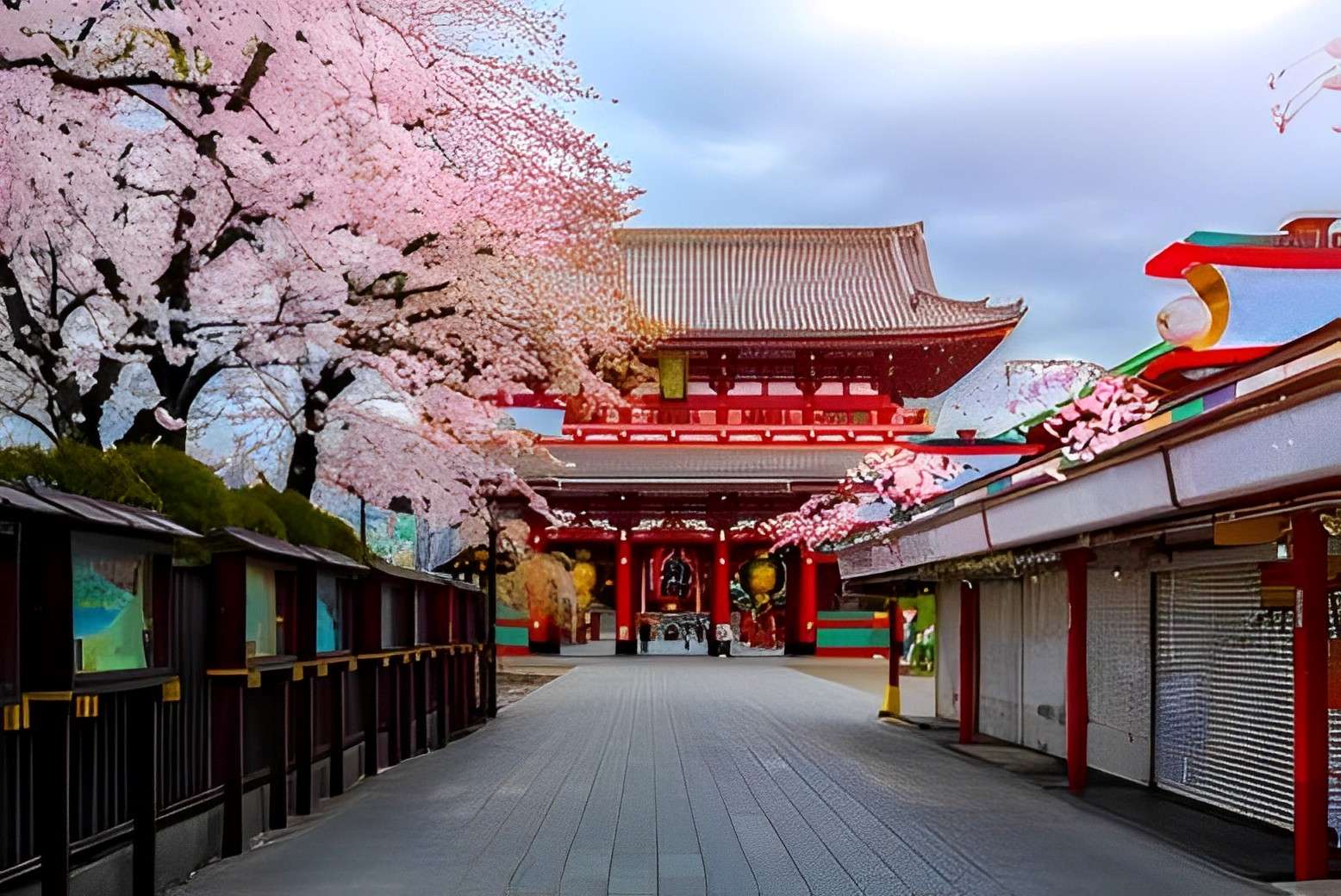Sensō-ji Temple is a Buddhist temple located in the Asakusa district of Tokyo, Japan. It is one of the most popular and oldest temples in the city, with a history dating back over 1,300 years. The temple is dedicated to Kannon Bosatsu, the goddess of mercy, and it is said to house one of her statues that was discovered in the nearby Sumida River by two fishermen in the 7th century.
The temple’s main entrance is through the Kaminarimon (Thunder Gate), a large and imposing gate with a giant lantern and two fierce-looking statues on either side. Beyond the gate is the Nakamise-dori, a colorful and bustling street lined with shops selling traditional Japanese snacks, souvenirs, and crafts. The Nakamise-dori leads to the second gate, the Hozomon Gate, which houses two large statues of Niō, the two wrathful and muscular guardians of the Buddha.
The main hall of Sensō-ji is a beautiful and ornate structure known as the Hondo. It is here that visitors can offer prayers and make offerings to Kannon Bosatsu. Adjacent to the main hall is a five-story pagoda, which offers a stunning view of the surrounding area.
Sensō-ji is also known for its annual festival, the Sanja Matsuri, which takes place in May and attracts over 1.5 million visitors. The festival features parades, music, food, and traditional performances, and is one of the most lively and colorful events in Tokyo. Overall, Sensō-ji is a must-visit attraction in Tokyo, offering a glimpse into Japan’s rich history and culture, as well as a peaceful and serene setting for reflection and contemplation.
Read about Japan more.
What is special about Sensō-ji Temple?

One of the most unique aspects of Sensō-ji is its approach to visitors. The temple’s entrance is marked by the Kaminarimon, a striking gate with a large red lantern and two imposing statues. Beyond the gate, visitors are greeted by a vibrant street filled with vendors selling traditional Japanese souvenirs and snacks. This approach to temple architecture is called Nakamise, which translates to “inside the gate” and has been a feature of Sensō-ji since the Edo period.
Another speciality of Sensō-ji is its annual festival, the Sanja Matsuri, which attracts millions of visitors from all over Japan and the world. The festival features lively parades, music, traditional performances, and a plethora of delicious food options, making it a vibrant and exciting celebration of Japanese culture.
Sensō-ji also offers visitors the opportunity to participate in traditional Buddhist practices, such as praying, making offerings, and experiencing the peaceful atmosphere of the temple’s gardens and halls. Overall, Sensō-ji ‘s speciality lies in its ability to provide visitors with a window into Japan’s rich cultural and religious traditions, all while offering a welcoming and inclusive atmosphere that reflects the country’s warm hospitality.
How to reach Sensō-ji Temple ?
If you are planning a trip to visit Sensō-ji Temple in Tokyo, Japan from India, here are some general guidelines to follow:
Check for entry requirements: Currently, Japan has entry restrictions for foreign travelers due to the COVID-19 pandemic. Before planning your trip, make sure to check the latest entry requirements and travel advisories issued by the Japanese government and the Indian government.
Obtain a valid visa: Indian citizens require a visa to enter Japan. You can apply for a visa at the Embassy or Consulate General of Japan in India or through a registered travel agency.
Book your flights: There are several airlines that operate flights from India to Tokyo, including Japan Airlines, Air India, and All Nippon Airways. You can book your flights online or through a travel agency.
Plan your accommodation: There are many hotels and guesthouses in Tokyo that cater to a variety of budgets and preferences. You can book your accommodation online or through a travel agency.
Plan your transportation: Tokyo has an extensive public transportation system, including trains, buses, and subways. You can purchase a rechargeable IC card such as Suica or Pasmo, which can be used to pay for transportation fares and other purchases.
Explore Sensō-ji : Sensō-ji Temple is located in the Asakusa district of Tokyo and can be easily accessed by public transportation. It is open to visitors every day of the year and admission is free. Don’t forget to explore the Nakamise-dori shopping street, which leads to the temple and is filled with traditional Japanese souvenirs and snacks. Remember to follow all safety protocols and guidelines issued by the Japanese government and the temple authorities, such as wearing a face mask, practicing social distancing, and avoiding crowded areas. With proper planning and preparation, you can enjoy a memorable trip to Sensō-ji Temple from India.
Best Time to visit Sensō-ji Temple ?

The best time to visit Sensō-ji Temple in Tokyo, Japan is during the spring (March to May) or autumn (September to November) seasons.
Spring in Tokyo is characterized by the blooming of cherry blossoms, which usually occurs in late March to early April. This is a popular time to visit the temple as the cherry blossoms provide a beautiful backdrop for photos and add to the overall ambiance of the temple grounds. However, it is important to note that this is also peak tourist season, so the temple and its surroundings may be crowded.
Autumn in Tokyo is characterized by cool, pleasant weather and colorful foliage, which usually peaks in November. This is a great time to visit the temple to enjoy the fall colors and escape the crowds that usually come with the cherry blossom season. The summer season (June to August) can be hot and humid in Tokyo, with occasional rain showers. The temple can be quite crowded during this season, especially during the Sanja Matsuri festival in May.
The winter season (December to February) can be cold in Tokyo, with occasional snowfall. While the temple can be less crowded during this season, some of the outdoor areas may be closed due to the weather. Overall, the best time to visit Sensō-ji Temple depends on your personal preferences and interests. If you want to see the cherry blossoms, spring is the best time to visit, but if you prefer cooler weather and fall foliage, autumn is the best time to visit.
Location of Sensō-ji Temple ?
Click me for google maps location.
Simply click on the link or copy and paste it into your browser to view the location of Sensō-ji Temple on Google Maps.
As this blog is written by a human few mistakes are possible and we know this blog is about a temple holy place so if anything you find inappropriate or misguiding please contact us.




